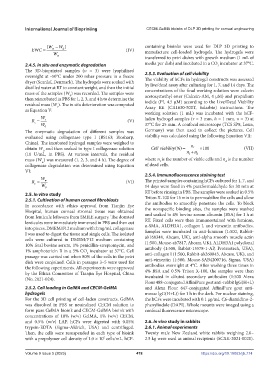Page 486 - IJB-9-5
P. 486
International Journal of Bioprinting CECM-GelMA bioinks of DLP 3D printing for corneal engineering
( W W ) containing bioinks were used for DLP 3D printing to
EWC w d (IV)
W manufacture cell-loaded hydrogels. The hydrogels were
w
transferred to petri dishes with growth medium (1 mL of
2.4.5. In situ and enzymatic degradation media per dish) and incubated in a CO incubator at 37°C.
2
The 3D-bioprinted samples (n = 3) were lyophilized
overnight at -50°C under 200 mbar pressure in a freeze 2.5.3. Evaluation of cell viability
dryer (Scanlaf, Denmark). The hydrogels were soaked with The viability of hCFs in hydrogel constructs was assessed
distilled water at RT to constant weight, and then the initial by live/dead assay after culturing for 1, 7, and 14 days. The
mass of the samples (W ) was recorded. The samples were concentrations of the final working solution were calcein
0
then reincubated in PBS for 1, 2, 3, and 4 h to determine the acetoxymethyl ester (Calcein-AM, 4 μM) and propidium
residual mass (W ). The in situ deterioration was computed iodide (PI, 4.5 μM) according to the Live/Dead Viability
r
as Equation V: Assay Kit (CA1630-500T, Solarbio) instructions. The
working solution (1 mL) was incubated with the hCF-
W laden hydrogel samples (r = 3 mm, h = 1 mm, n = 3) at
R = r (V)
s
W 0 37°C for 25 min. A confocal microscope (TCS SP8, Leica,
The enzymatic degradation of different samples was Germany) was then used to collect the pictures. Cell
evaluated using collagenase type I (BS163; Biosharp, viability was calculated using the following Equation VII:
China). The incubated hydrogel samples were weighed to
obtain W and then soaked in type I collagenase solution Cell viability (%) n l 100 (VII)
0
(10 U/mL, in PBS). At various intervals, the residual n n d
l
mass (W ) was measured (1, 2, 3, and 4 h). The degree of where n is the number of viable cells and n is the number
d
l
w
collagenase degradation was determined using Equation of dead cells.
VI: 2.5.4. Immunofluorescence staining test
W
R = w (VI) The printed samples containing hCFs cultured for 1, 7, and
e
W 0 14 days were fixed in 4% paraformaldehyde for 30 min at
RT before rinsing in PBS. The samples were soaked in 0.5%
2.5. In vitro study
2.5.1. Cultivation of human corneal fibroblasts Triton X-100 for 15 min to permeabilize the cells and allow
In accordance with ethics approval from Tianjin Eye the antibodies to smoothly penetrate the cells. To block
Hospital, human corneal stromal tissue was obtained the nonspecific binding sites, the samples were washed
from lenticule leftovers from SMILE surgery. The donated and soaked in 4% bovine serum albumin (BSA) for 1 h at
lenticules were immediately immersed in PBS and then cut RT. Fixed cells were then immunostained with lumican,
into pieces. DMEM/F12 medium with 2 mg/mL collagenase α-SMA, ALDH3A1, collagen I, and vimentin antibodies.
I was used to digest the tissue and single cells. The isolated Samples were incubated in anti-lumican (1:500, Rabbit-
cells were cultured in DMEM/F12 medium containing ab168348, Abcam, UK), anti-alpha smooth muscle actin
10% fetal bovine serum, 1% penicillin‒streptomycin, and (1:500, Mouse-ab7817, Abcam, UK), ALDH3A1 polyclonal
1% amphotericin B in a 5% CO incubator at 37°C. Cell antibody (1:500, Rabbit-15578-1-AP, Proteintech, USA),
2
passage was carried out when 80% of the cells in the petri anti-collagen I (1:500, Rabbit-ab260043, Abcam, UK), and
dish were conjoined. Cells in passages 3–5 were used for anti-vimentin (1:500, Mouse-SAB4200716, Sigma, USA)
the following experiments. All experiments were approved antibodies overnight at 4°C. After washing three times in
by the Ethics Committee of Tianjin Eye Hospital, China 4% BSA and 0.5% Triton X-100, the samples were then
(No. 2021-024). incubated in diluted secondary antibodies (1:500 Alexa
Flour 488-conjugated AffiniPure goat anti-rabbit lgG(H+L)
2.5.2. Cell loading in GelMA and CECM-GelMA and Alexa Flour 647-conjugated AffiniPure goat anti-
hydrogels mouse lgG(H+L)) for 1 h in the dark. For nuclear staining,
For the 3D cell printing of cell-laden constructs, GelMA the hCFs were incubated with 0.1 μg/mL 4’,6-diamidino-2-
was dissolved in PBS or neutralized CECM solution to phenylindole (DAPI). Whole mounts were imaged using a
form pure GelMA bioink and CECM-GelMA bioink with confocal fluorescence microscope.
concentrations of 10% (w/v) GelMA, 1% (w/v) CECM,
and 0.5% (w/v) LAP. hCFs were digested with 0.05% 2.6. In vivo study in rabbits
trypsin-EDTA (Sigma‒Aldrich, USA) and centrifuged. 2.6.1. Animal experiments
Then, the cells were resuspended in each type of bioink Twenty male New Zealand white rabbits weighing 2.0–
with a prepolymer cell density of 1.0 × 10 cells/mL. hCF- 2.5 kg were used as animal recipients (SCXK-2021-0020).
5
Volume 9 Issue 5 (2023) 478 https://doi.org/10.18063/ijb.774

